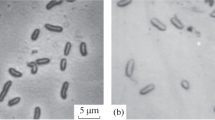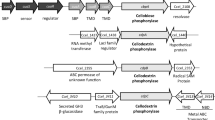Abstract
The gram-negative cellulase-producing bacterium NCIMB 10462 has been previously namedPseudomonas fluorescens subsp. or var.cellulosa. Because of renewed interest in cellulose-degrading bacteria for use in the bioconversion of cellulose to chemical feed stocks and fuels, we re-examined the characteristics of this microorganism to determine its true metabolic potential. Metabolic and physical characterization of NCIMB 10462 revealed that this is an alkalophilic, nonfermentative, gram-negative, oxidase-positive, motile, cellulose-degrading bacterium. The aerobic substrate utilization profile of this bacterium has few characteristics consistent with a classification ofP. fluorescens and a very low probability match with the genusSphingomonas. However, total lipid analysis did not reveal that any sphingo-lipid bases are produced by this bacterium. NCIMB 10462 grows best aerobically, but also grows well in complex media under reducing conditions. NCIMB 10462 grows slowly under anaerobic conditions on complex media, but growth on cellulosic media occurred only under aerobic conditions. Total fatty acid analysis (MIDI) of NCIMB 10462 failed to group this bacterium with a known pseudomonas species. However, fatty acid analysis of the bacteria when grown at temperatures below 37°C suggest that the organism is a pseudomonad. Since a predominant characteristic of this bacterium is its ability to degrade cellulose, we suggest that it be calledPseudomonas cellulosa.
Similar content being viewed by others
References
Ueda, K. S. Ishikawa, Itami, T., and Asai, T. (1952),J. Agr. Chem. Soc. Jpn. 26, 35.
Yame, K., Suzuki, H., Hirotani, M., Ozawa, H., and Nisizawa, K. (1970),J. Biochem. 67, 9–35.
Hall, J. and Gilbert, H. J. (1988),Mol. Gen. Genet. 213, 112–117.
Hazlewood, G. P., Laurie, J. I., Ferria, L. M. A., and Gilbert, H. J. (1992),J. Appl. Bacteriol. 72, 244–251.
Hong, Y., Pasternak, J. J., and Glick, B. R. (1990),Curr. Microbiol. 20, 339–342.
Wolff, B. R., Lewis, D., Pasternak, J. J., and Glick, B. R. (1990),J. Ind. Microbiol. 5, 59–64.
Osterhout, G. J., Schull, V. H., and Dick, J. D. (1991),J. Clin. Microbiol. 29, 1822–1830.
Ikuya, Y., Ikuko, T., and Eiko, Y. (1982),FEMS Microbiol. 15, 303–307.
Akihiro, Y., Ikuya, Y., Masamiki, M., and Eiko, Y. (1978),J. Biochem. 83, 1213–1216.
Sonnesson, A., Moll, H., Jantzen, E., and Zähringer, U. (1993),FEMS Microbiol. 106, 315–320.
Mills, C. K., Kefauver, M. B., and Gherna, R. L. (1989), Abstracts of the 89th Annual Meeting of the American Society for Microbiology, p. 283.
Hamwood, J. I. and Russell, N. J. (1984), inLipids in Plant and Microbes. George Allen, p. 78.
Rutledge, C. and Wilkinson, S. G. eds. (1988),Microbial Lipids, vol. 1, Academic, pp. 333–339.
Heipieper, H. J., Piefenbach, K., and Keveloh, H. (1992),Appl. Environ. Microbiol. 88, 1847–1852.
Guekat, J. B., Ringelberg, D. B., and White, D. C. (1987),Can. J. Microbiol. 88, 749–754.
Author information
Authors and Affiliations
Additional information
The submitted manuscript has been authored by a contractor of the US government under contract No. DE-AC05-84OR21400. Accordingly, the US government retains a nonexclusive, royalty-free license to publish or reproduce the published form of this contribution, or allow others to do so, for US government purposes.
Managed by Martin Marietta Energy Systems, Inc., under contract no. DE-AC05-84OR21400 with the US Department of Energy.
Rights and permissions
About this article
Cite this article
Dees, C., Ringelberg, D., Scott, T.C. et al. Characterization of the cellulose-degrading bacterium NCIMB 10462. Appl Biochem Biotechnol 51, 263–274 (1995). https://doi.org/10.1007/BF02933429
Issue Date:
DOI: https://doi.org/10.1007/BF02933429




